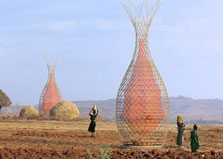
In the Namib desert where rain is rare but fog common, a beetle survives by condensing water on its back until drops roll down into the insect's mouth. Now this principle has been magnified onto a grand scale, providing a possible solution to the desperate lack of water that plagues the populations of many of the world's dry regions.
There is no lack of solutions being experimented with for water shortages. Wells, recycling techniques and methods for cleaning poisoned water have all attracted considerable efforts, particularly since the Bill and Melinda Gates foundation have made the issue a priority for their considerable resources.
However, many of these techniques have floundered; great on the page but unsuited to real world conditions. Those technologies that are cost effective represent only partial solutions, working well where a permanent water supply is available, but unsuited to regions where surface water vanishes in the dry season and groundwater is hard to reach. As deforestation and Global Warming expand the areas where water is scarce or erratic something else is needed.
While Warka Water needs to be treated with caution after so many false dawns, it has the advantage of being designed to match the conditions where most alternatives perform the worst.
The towers have a 9m tall bamboo or juncus frame holding up a plastic mesh net. As the temperature falls during the night water condenses onto the net and rolls down to a reservoir at the bottom of the tower. Where the beetle draws just a few life-giving drops from the Namib fog, the much larger surface area of the nets allows a 100l a night to collect under ideal conditions. Mesh is used, rather than a solid surface, so that air can circulate, bringing in ever more water.
As the designers Arturo Vittori and Andrea Vogler put it, “The lightweight structure is designed with parametric computing, but can be built with local skills and materials by the village inhabitants."
The beetle has proven an inspiration to many but Warka Water claim their carefully shaped design produces much more water for less cost than previous versions.
The Warka Water tower is named after a fig tree native to Ethiopia, and depends for its success on a large temperature difference over a night. Since desert regions are notorious for huge temperature variations, particularly during the dry season, Warka towers should flourish where they are needed most.
"It's not just illnesses that we're trying to address,” Vittori told the Smithsonian Magazine, although with 1400 children a day dying from waterborne diseases that would be reason enough. “Many Ethiopian children from rural villages spend several hours every day to fetch water, time they could invest for more productive activities and education,” Vittori says. “If we can give people something that lets them be more independent, they can free themselves from this cycle."
Vittori hopes to install two Warka Towers in Ethiopia next year, and believes that, “Once locals have the necessary know-how, they will be able to teach other villages and communities to build the Warka.” Cost estimates for the remote constructions of systems are notoriously unreliable, but Vittori believes the towers can be built for $500 each, a quarter or systems that purify equivalent amounts of water. They are seeking sponsorship to bring the idea to fruition. While we suggest Warka Beer would be a great fit, anyone wanting to get behind the idea should get in touch.
